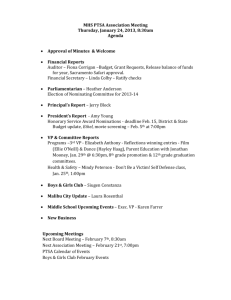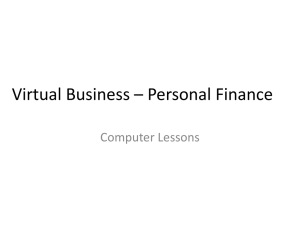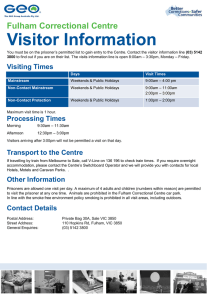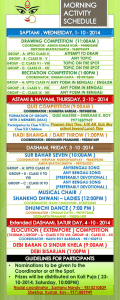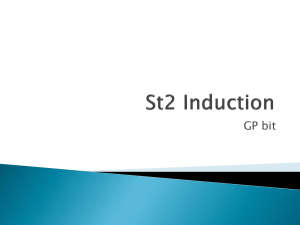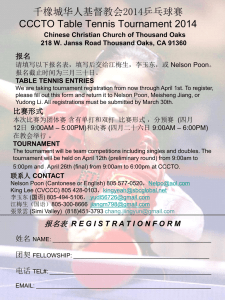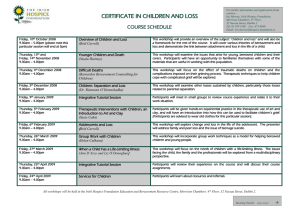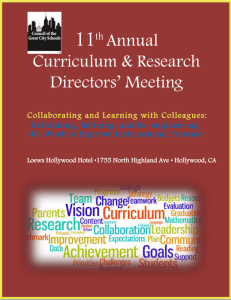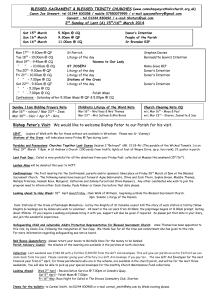Language for Learning Model - WELB Curriculum and Advisory
advertisement
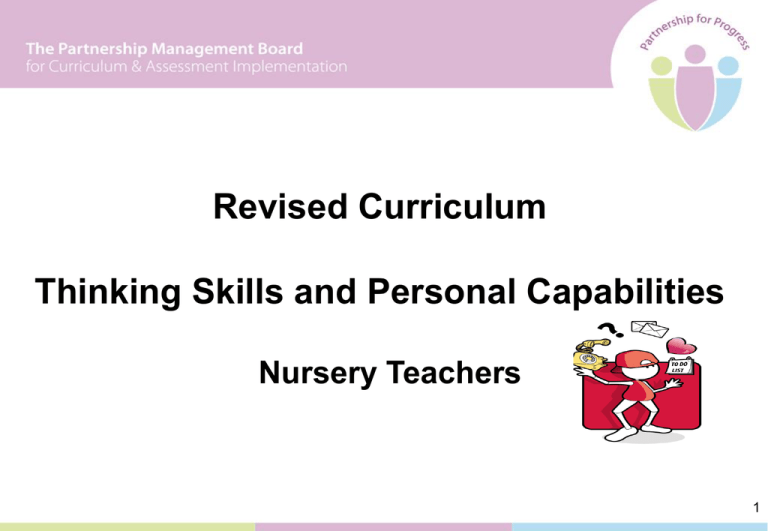
Revised Curriculum Thinking Skills and Personal Capabilities Nursery Teachers 1 Programme 9.30am – 10.00am Welcome, Introductions Background to Northern Ireland Curriculum 10.00am – 10.30am Workshop 10.30am – 11.00am Coffee 11.00am – 11.30pm Examining the Stands of TS&PC 11.30am – 12.15pm Ethos, strategies and the environment 12.15am- 13.00pm Incorporating TS &PC 1.00pm – 2.00pm Lunch 2.00pm – 3.00pm Questioning 3.00pm - 3.15pm Review and Looking Ahead Evaluation 2 The big picture The Big Picture 3 The Vision The Big DE Picture The vision of the Department of Education is to educate and develop the young people of Northern Ireland to the highest possible standards providing equality of access to all 4 Workshop The Nursery Child 5 Coffee break 6 Why thinking Skills and Personal Capabilities Thinking Skills and Personal Capabilities enable pupils to learn how to learn 7 ‘Thinking skills are the tools that help children to go beyond the acquisition of knowledge to search for meaning,applying ideas analyse patterns and relationships, create and design something new and monitor and evaluate their progress’ Northern Ireland Curriculum Primary 8 Thinking, Problem Solving Decision Making Managing Information Being Creative & Working with Others Self Management 9 Managing Information • Work with a focus, ask and respond to questions to clarify the task • Select with help, information from materials and resources provided and suggest ways to obtain information • Follow directions in relation to a task • Begin to plan • Identify and record simple methods to record information 10 Thinking, Problem Solving Thinking Problem –Solving and Decision Making Decision Making • Show their ability to memorise by recalling restructuring experiences and stories • Make close observation and provide descriptions of what hey notice • Show the ability to sequence and order events and information and to see wholes and pars • Identify and name objects and events as same / different, sort and put objects into groups • Give opinions and reasons • Ask different types of questions 11 Being Creative • Be curious and ask questions about the Being Creative world around them, using all the senses to explore and respond to stimuli • Talk about their memories and experiences • Play for pleasure and as a form of creative expression • Show excitement, enjoyment and surprise in learning • Be willing to take on new challenges • Experiment with ideas through writing, drawing, mark making and model making 12 Working with Others Working with Others • Be wiling to join in • Learn to work and play cooperatively • Develop routines of listening, turn taking, sharing, co-operating and reaching agreement • Be able to learn from demonstrating and modelling • Be aware of how their actions can affect others • Learn to behave and use words to suit different purposes • Develop a confidence at being with adults and other children in a variety of contexts 13 Self Management Self - Management • Talk about what they are doing and what they have learnt • Develop the ability to focus, sustain attention and persist with tasks • Develop awareness of emotions about learning, their likes and dislikes • Be able to make choices and decisions • Ask a friend for help 14 What are the benefits to the children? • • • • • Active engagement Deepening understanding Habits and dispositions Greater independence Ability to transfer skills and capabilities 15 Add a Comment Model Accept Mistakes Question Provide Open Tasks Make Links Scaffold Allow time Foster Creativity TEACHING STRATEGIES Offer Alternatives Encourage Observing Listen Promote Reflection Introduce Critical Thinking Introduce Ambiguity Provide Challenge 16 Children’s own work evident Attractive Displays Thinking aids on display Child’s ownership PHYSICAL ENVIRONMENT Colourful and Spacious Outdoor facilities available Stimulating Wellorganised 17 Friendly Relaxed Supportive Encouraging LEARNING ETHOS Challenging Welcoming Caring 18 Workshop Putting it into practice 19 Lunch 20 Effective Questioning Workshop Shauna McCrea and Emma Brown, Advisory Speech and Language Therapists WELB/WHSCT The Speech and Language Project 21 Aims for session are Aims for session • To empower teachers to use the Language for Learning Model in context of questioning. • Use the Language for Learning Model to explore TS +PC • Ask quality questions pitched at child’s level 22 We will…….. • Place responding to questions in the context of communication processes • Relate LfL to other systems of questioning • Introduce the Language for Learning Model as a tool for developing more effective questioning • Provide opportunity to apply the Model in a practical session • Introduce screening tool • Respond to questions 23 The Communication Chain Ideas Understand: individual words = semantics and meaning of sentence, literal & underlying Decide Choose words Choose appropriate sentence structure Remember = auditory memory Select the sounds = phonology Hear Co-ordinate instructions to the speech muscles Listen Articulate sounds Look/Attend Self monitor Speak appropriately Produce voice Speak fluently 24 The focus of this model is… • Your expressive language and the children’s receptive language • A qualitative approach to receptive language • This broad focus may well indicate difficulties in receptive language that will require a narrowing of the analysis of children’s responses 25 The Language For Learning Model Blank, Rose, and Berlin(1978) Materials produced by Liz Elks and Henrietta McLachlan of Elklan Training 26 Elklan Speech and Language Support for under 5s Session 5 27 Language for Learning Model I Teaching materials Language demands Language matches the materials. Looking at the whole object 28 Level 1 Questions • • • • • What’s this? Where are the plant pots? Find another one like this (show a bulb). Where’s the ……? What did you see on the table? 29 Language for Learning Model Teaching materials Language demands I Language matches materials, looking at the whole object II Language relates to the materials but child focuses selectively on parts of the object. 30 Level 2 Questions • • • • • Which one do we dig with? You can water the garden with a ……… Find me something that is big Find a big black pot What else can you find here that we put in the ground? • What is different about the fork and the trowel? 31 Level 2 Questions • What goes with a fork? • Name something that is a plant. • Mum planted the bulbs in the garden. Who planted the bulbs? • Where was she? • What did she plant? • Show a planting bulb picture. What is happening in the picture? 32 Language for Learning Model Teaching materials Language demands I II Language Language matches relates to the materials, materials but seeing the child focuses whole object selectively on parts of the object III Language does not map directly to materials. Use language & materials to organise response. See the object in its context 33 Level 3 Questions • I want you to, put the bulb in the top, add soil with the trowel then tap it down • Find me something else you can put plants in which is not made of plastic • How are these the same? • What does ‘sow’ mean? 34 Level 3 Questions • • • • • • Arrange pictures in a sequence Tell me how to plant the bulb The flower looks lovely, what does Mum say? Tell the story What might happen next? Summarise the story in one sentence 35 Language for Learning Model I Teaching materials Language demands Language matches materials, looking at the whole object II Language relates to the materials but child focuses selectively on parts of the object III Language does not map directly to materials. Use language & materials to organise response. See object in it’s context IV Demands go beyond materials. Have to use language to justify & solve problems 36 Level 4 Questions • Why will the bulb grow? • Why did you use a watering can to water the flowers? • What made the plant grow? • What could you do if the plant doesn’t grow? • What could Mum do if the plant doesn’t grow? 37 Level 4 Questions • • • • How can we tell that this trowel is old? How could we grow a plant without soil? Why do we plant the bulbs in a pot? Why is this called a flower pot? 38 Percentage of Children Able to Respond at Different Language for Learning Levels Level I Naming things Level II Describing things Who? What? Where? Level III Talking about stories and events Level IV Solving problems and answering Why? 60% of 3 year olds understand at level I and level II 65% of 5 year olds understand at level III and level IV 39 Language for Learning Practical 40 To Conclude • Implications of the range of LfL levels presenting in your class • The 80/20 rule • Self reflection sheet • The LfL levels and behaviour • The TALC screening tool • Keep within context of overall language development levels. 41 Questions (effective ones of course!) 42 Objectives: • To increase participants’ knowledge and understanding of the Thinking Skills and Personal Capabilities framework • To identify practical opportunities for the infusion of Thinking Skills and Personal Capabilities 43 ‘Thinking skills are the tools that help children to go beyond the acquisition of knowledge to search for meaning,applying ideas analyse patterns and relationships, create and design something new and monitor and evaluate their progress’ Northern Ireland Curriculum Primary 44
